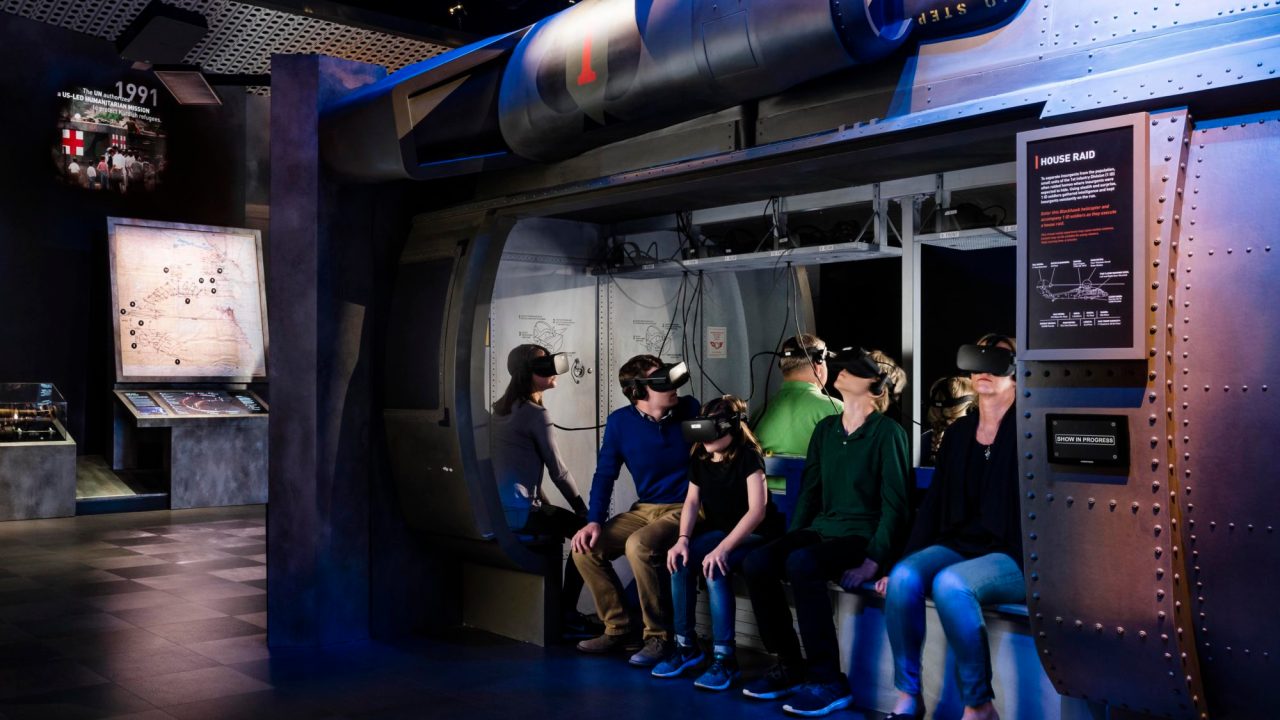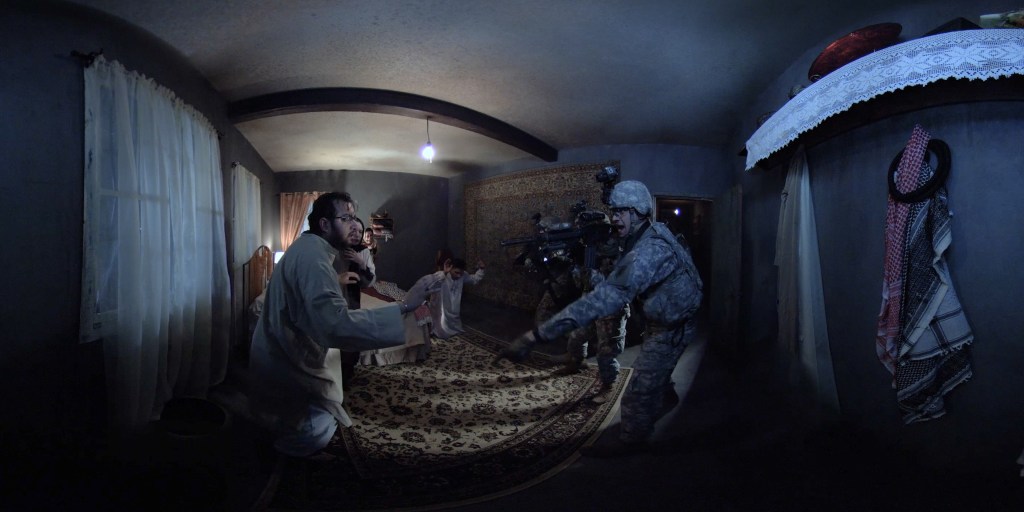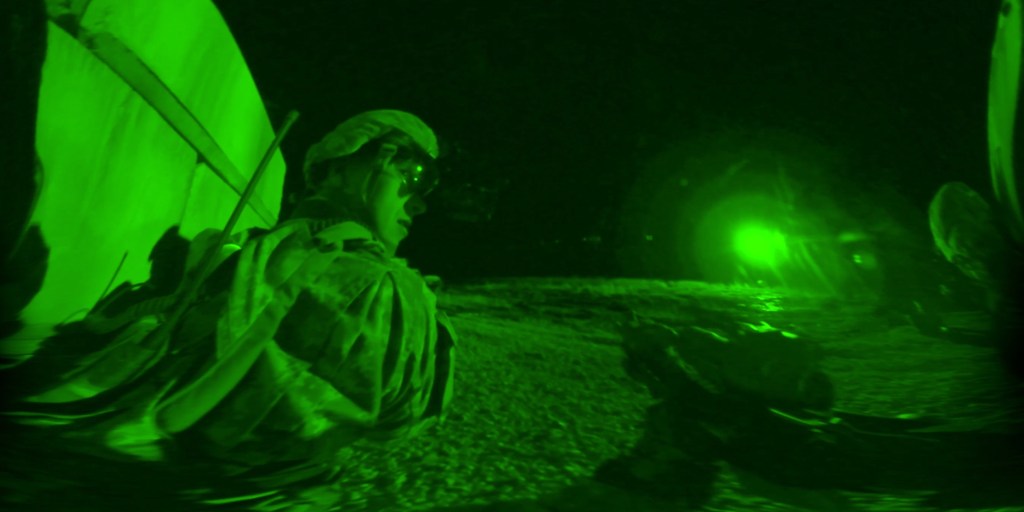
Virtual Reality (VR) and Augmented Reality (AR) are coming to a museum near you. The Sep/Oct 2017 cover of AAM’s Museum featured a photo of a young woman wearing a VR headset at the American Museum of Natural History’s Hall of Biodiversity. Walk the floor of any museum conference expo, and you’ll see vendors promoting VR and AR hardware, software, and content. The keynote speaker at the most recent Association of Science and Technology (ASTC) conference was Brendan Iribe, co-founder and vice president at Oculus. And one of the most popular new exhibits at Philadelphia’s Franklin Institute is called – what else? – Virtual Reality.
However, for most museums, VR and AR still seem far out of reach, from both a cost and technical know-how perspective.
At the First Division Museum (FDM), in Wheaton, Illinois, the brand new museum expansion includes a VR experience where visitors sit inside a Blackhawk helicopter, wear headsets, and then virtually accompany U.S. Army soldiers as they raid the home of a suspected insurgent in the Middle East. Luci Creative worked with FDM for two years on the development and technical finessing of this VR experience. Along with our partners, Northern Light Productions, Ravenswood Studio, and Creative Technologies, we learned quite a lot along the way about what works and what doesn’t. Based on our experiments, failures, and successes, here are 6 tips for working with virtual reality in a museum.
- Focus on the Story. Content is King! As with any technology used in museum settings – from simple touchscreens to multiple video projections – the goal should be for the hardware to disappear, so that the visitor can be fully immersed in the content, whether that’s imagery, a story, or information. For the FDM VR experience our team was guided by members of the U.S. Army, the stars of the film are actual soldiers of the First Division, and every nuance was considered when we built the set at Fort Riley. This attention to detail and accuracy allowed the content to shine and the headsets to disappear.
-
More is Better. The FDM VR experience would not have worked with only one or two headsets. The Blackhawk seats 12 visitors, and there are 12 VR headsets. This was done for a few reasons. First, it was important that the VR film could be experienced as a group or family, with people sitting together. Second, with a six-minute program, it was essential to accommodate as many visitors as possible, especially on busy weekends. And lastly, we recognized that there would be times when some of the headsets are in maintenance, but that the experience should still be open and available.

First Division Museum (FDM), Wheaton, Illinois
- Trick the Technology. It took a lot of testing and dead ends to come up with some workarounds to the out-of-the-box features of the Oculus Rift. First, when not being used, the USB connection goes into Low-Power Mode, which means that visitors put on headsets that have to reboot. So, we adjusted the settings so that the USB connection is always in Performance Mode, and the headsets are ready to go. Second, since the FDM VR exhibit is a seated experience, we didn’t need the sensors that detect a person’s in-and-out range. For this, we installed the sensors near the AV rack, where there’s no movement, tricking the system into thinking that everything is working fine.
- Use First and Third Person. The FDM VR experience begins with the visitor sitting among soldiers on a Blackhawk helicopter at night. Seconds later, as the soldiers approach the building on foot, the visitor feels like he’s right there with them. But during the six-minute program, there are also moments where the visitor is viewing the soldiers from afar – though still in 360˚ – as though they’re across the yard or on TV. By moving between first and third person viewing, it provides more visual context and maintains the focus on the story. We found that this also helps to keep visitors from feeling dizzy or nauseous.
-
Embrace Fragility. Most VR headsets, at this time, aren’t built for heavy commercial use. They’re designed for gaming and watching videos at home. The nearly constant use of a VR headset in a museum setting puts untested wear and tear on the product. The Oculus Rift foam padding, plastic housing, straps, and headphones on the FDM Blackhawk experience have been taking a beating, and need to be cleaned, repaired, and replaced frequently. The good news is that companies, such as Sensics, Oculus, and HTC, have recently released commercial-grade VR products, and more are sure to follow.

First Division Museum (FDM), Wheaton, Illinois
- Staff Up! Because VR is still new, most visitors won’t be as familiar with the hardware and interface as we all now are with our smartphones. It’s good to have an employee or volunteer on hand to constantly monitor the situation and to ensure that visitors are having a positive experience. At FDM, there’s always a docent nearby, helping visitors to put on their headsets and set up the program. Also, it’s vital to have skilled, internal IT staff who can troubleshoot and resolve technical issues quickly, and who speak the same language as those on telephone customer support.
Working on the FDM Blackhawk VR exhibit was a major learning experience for all of those involved. And it’s a treat to know that thousands of visitors have enjoyed and been moved by the exhibit since its August opening. Groucho Marx said, “Learn from the mistakes of others. You can never live long enough to make them all yourself.” Our team at Luci Creative hopes that museums, exhibit designers, and media developers can learn from both our mistakes and our successes with VR.
About the Author
David Whitemyer is the Director of Business Development at Luci Creative, an exhibit design firm, and an instructor in Johns Hopkins University’s Museum Studies program. He can be reached at david@lucicreative.com









Thanks for this, David! Lots of AR and VR discussions at MCN too.
And thank YOU, Phyllis! I’m looking forward to the spring semester. I can’t believe it’s here already.
Hi David, great to read about your experiences. At the National Museum of Australia we’re running a small 80 seat capacity theatre dedicated to VR films and have welcomed almost 30,000 visitors this year. Looking forward to hearing more in this space!
Tina, I’d love to hear more about your 80-seat VR experience! It must be incredible.